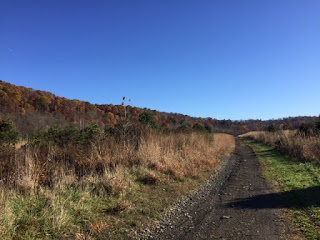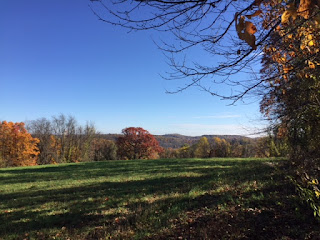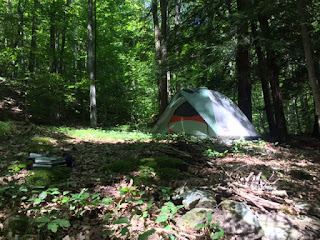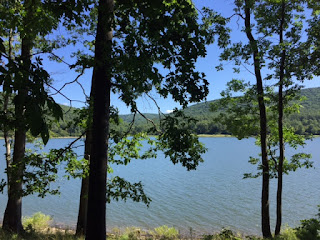I continued my exploration of the West Penn Rail Trail at the spot where I left off last time: the Tunnelton Road trailhead, eastbound. The trail through much of this section does not follow an old railbed, and the hills are pretty daunting in places. Soon enough you'll find yourself staring at this contraption on the Conemaugh River.
Somehow, I was vaguely aware of the existence of Loyalhanna Lake and believed that the West Penn Trail would cross it. Instead, it crosses the Conemaugh River at a spot with the ungainly name of "Conemaugh River Lake." But it's only a lake when the water levels are high. There are parks on both Loyalhanna and Conemaugh lakes. But the park at Loyalhanna is much bigger and includes a campground. This nice intersection of railroad trestles made for a curious view. The West Penn Trail runs along the higher of the two roadways.
This is the Conemaugh River as seen from the bridge. The river winds a zig-zag course between the hills in this area, and the old railbed just plows a straight line through hill and across river by means of bridges and tunnels. The West Penn Trail follows the old bridges, but it does not run through the tunnels. Instead, it meanders up into the hills and gives you a lot of ups-and-downs.
This tunnel is now blocked, and the trail follows a roadway to the left, then down, then up the hill. Very unorthodox for a rail trail.
The original tunnel must have been really long.
After snaking up the hillside, over the summit, and back down the other side, you finally see the spot where the old railroad emerged from the tunnel, onto a long bridge, and over another segment of the Conemaugh River...or lake...or whatever this glowering gray body of water is called.
But on your way down to water level, you've got to maneuver down these sinister steps, which put me in mind of the old city steps of Pittsburgh and Oil City--except with steep ramps along the side for walking your bike. This section is slow-going because both uphill and downhill segments are too steep to ride.
The old railroad bridge is littered with river debris. The dam causes the water levels here to change, and it's said that this portion of the trail is impassable in high water. There's a strangely foreboding quality to this landscape on a colorless November day. I felt too exposed out on this bridge, as if some long-necked sea monster might raise its hoary head from the murky water and snap at me with sopping maws.
And here, looking over your shoulder to the hill you've just descended, is the east side of that same clogged tunnel, all caged up tight.
Whereas my first day out on the West Penn Trail was glorious and almost magical, this day had a dreariness to it. Because the river at this spot becomes a lake from time to time, the banks are choked with driftwood and dead weeds. The countryside was all shorn of autumn colors, aside from the somber, leathery oak leaves still clinging to the trees. All was silent and gray.
But still...better than being in Pittsburgh--or any city. Because the Conemaugh travels in a twisted coil at this spot, the trail runs a straight line over several river crossings. Through the woods to the right of this photo, I spied a cemetery that I went off trail to explore. Alas, there were so many "No Trespassing" signs surrounding the place that I aborted the mission. (A few early hunters were lingering in the area, and I didn't want to get caught.)
I did ride the bike a short distance down the road where my next trip on the West Penn Trail will begin. Farm country under gray skies.
Upon the return trip, I found an overlook with a view out onto the dam. Not a spectacular day in the forest, but a fine one. I hope to finish the rest of the trail--Cemetery Road to Blairsville--next week. We'll see if that happens. Hunting season will be in full swing, I think.

















































